Alicante University geology students visit Ojos Negros quarry
Students of the third course of Geology of the Alicante University within the subject of Regional Geology: visit the abandon Ojos Negros quarry. This is an excellent Ordovician-Silurian section of the Hirnantian glaciation.
The picture shows the student at the quarry border.

Spanish Geological Congress in Avila
A paper on geological cycles during the Eocene in the Prebetic (SE Spain) was presented at the XI Spanish Geological Congress held Ávila (Spain) from July 1 to 6, 2024. The picture show the poster and the participant José Enrique Tent-Manclús.
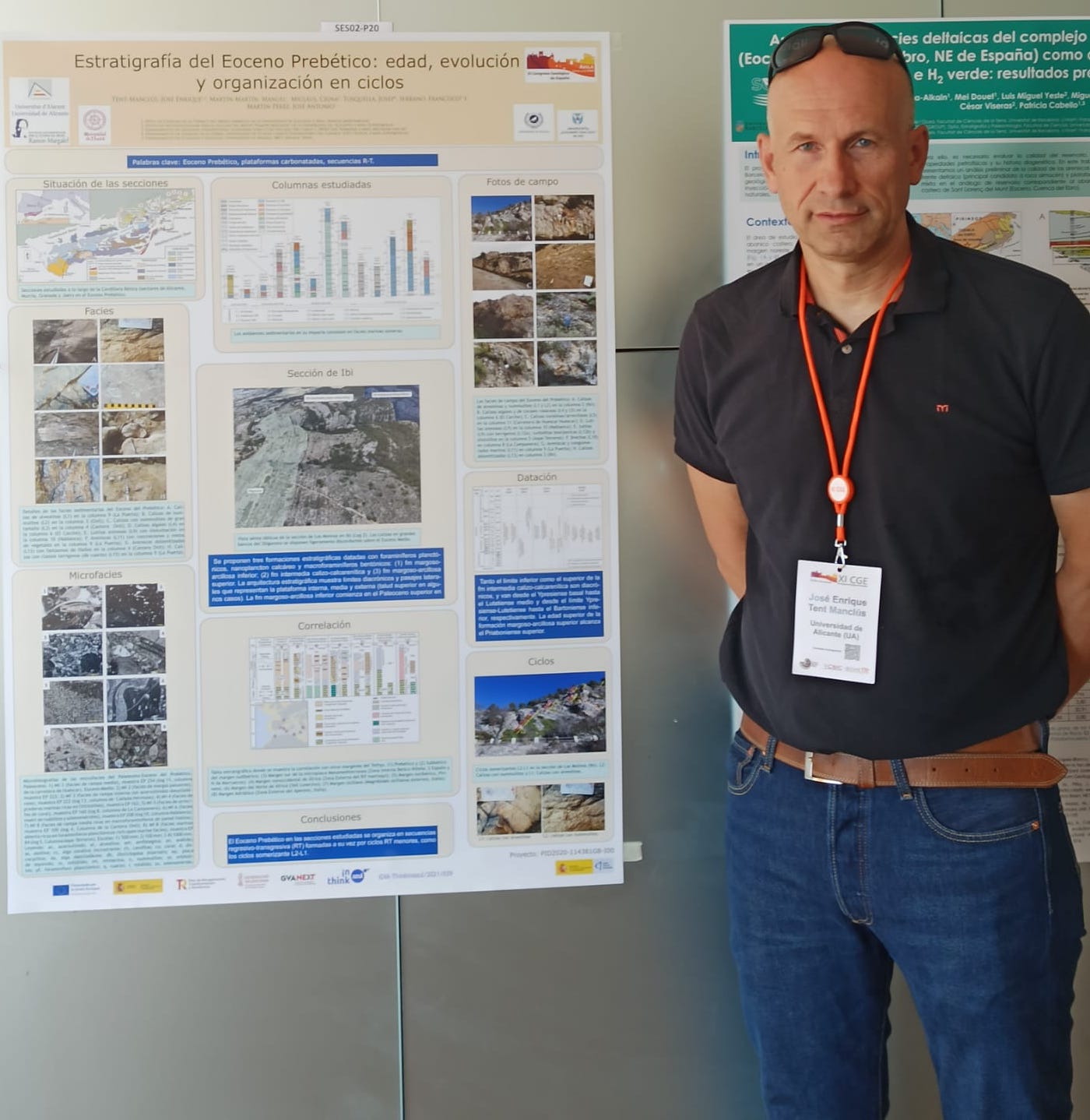
Miocene evolution Moroccan External Rif Zone
The Miocene evolution of the External Rif Zone (NW Africa Plate) was determined through multidisciplinary analysis of fourteen successions. The updated stratigraphic framework shows how Miocene sediments rest on the Cretaceous–Paleogene terrains through unconformity surfaces, whereas it rests with sedimentary continuity in two sectors. After recognition of lithofacies and three unconformities located near the Oligocene–Aquitanian, Aquitanian–Burdigalian and Serravallian–Tortonian boundaries, the Miocene sedimentary record was divided into three stratigraphic intervals representing deep to shallow marine deposits as Aquitanian–Burdigalian, Langhian and Upper Serravallian–Missinian. The two oldest unconformites are restricted to the central sector, while the upper one is generalized and probably related to the nappe tectonics registered in all sectors of the External Rif. Data from analysis of tectofacies, petrology, mineralogy, meaning and implications of unconformities, and subsidence indicate that: (i) mass flow deposits (turbidites, slumps, olistostromes) are common in all successions but more frequent during the Lower Miocene; (ii) petrology of the detrital components of the arenites indicates recycled orogen-derived sediments, with quartz coming from erosion of metamorphic rocks of the Atlas orogen and/or the African craton; (iii)mineralogy of mudstones suggests a complex erosional evolution of local emerged areas derived from a mixture of contributions coming from the erosion of Upper Jurassic to Paleogene suites, and especially from kaolinite-rich Albian–Cenomanian to Paleogene successions with absence of a clear unroofing.

Display of the 3D structural model performed with Python codes; see file 3D_ZER_structural_model.HTML
The conjunction of all these clues reinforces the idea of a synsedimentary tectonics affecting themargin/basin system during the Miocene. A thickness analysis of the studied sedimentary successions allows proposing the evolution of the orogenic front and main depozones (foredeep, bulges, wedge-top and intramontane sub-basins) integrated in a complex foreland system migrating from north to south with the Atlas-Mesetas area acting as foreland during Miocene. The orogenic front moved from the Internal Intrarif to Mesorif and later to Internal Prerif. The main wedge-top basin also migrated from the Internal Intrarif to External Intrarif. The foredeep migrated from the Mesorif to the Internal Prerif,while the main forebulge was located in the External Prerif and a secondary bulge developed in the External Intrarif. Intramontane basins developed behind the orogenic front in relative extensional conditions moving from the Internal Intrarif to External Intrarif. The reconstructed Miocene evolution was inserted into a 2D paleogeographic geodynamic evolutionary model using GPlates software, and then compared to those reported in other external margins of the western Tethys (Betic Chain, Tunisian Tell, Sicilian Maghrebids and Apennines), revealing important similarities and local differences.
Cenozoic tectono-sedimentary evolution of the onshore-offshore Tunisian Tell: Implications for oil-gas research
A review of the paleogeographic and tectonic reconstruction of the onshore and offshore Tunisian margin during the Cenozoic is discussed. Five unconformities (A to E) and associated stratigraphic gaps of various vertical extents allow subdivision of the stratigraphic record into depositional units in the following time intervals: (i) Paleocene-Oligocene, (ii) Oligocene-early Aquitanian, (iii) early Aquitanian-Burdigalian, (iv) late Burdigalian-Langhian and (v) Langhian-late Miocene. These intervals can in turn be grouped into four main sedimentary cycles (SC1–SC4) dated to the (1) Paleocene-Oligocene, (2) Oligocene–Burdigalian, (3) Burdigalian-Langhian and (4) Langhian-late Miocene. The oldest depositional unit reflects Eo-Alpine tectonics in the Maghrebian Flysch Basin (MFB); the others are related to the Neo-Alpine syn- and late orogenic tectonic deformation affecting the MFB. The uppermost unit represents post-orogenic deposition. Early Miocene synsedimentary tectonism led to (1) deposition of thick successions owing to a large sediment supply and (2) the occurrence of various tectofacies (unconformities, slumps, mega-turbidites, olistostromes, growth folds, chaotic intervals and heterogenous lithofacies), that all, together with the occurrence of lateral change of facies, clearly indicate non-cyclical sedimentation. During the middle Miocene the Tunisian Tell underwent polyphase thrust tectonism, followed by late Miocene strike-slip deformation with contemporaneous rejuvenation of halokinetics and magmatism (the La Galite Archipelago) that may be traced as far as the Algerian Tell. The margin experienced deep-seated compressional tectonism during the Paleogene, a foreland basin during the early Miocene, and nappe stacking during the middle Miocene, with the occurrence of wedge-top sub-basins. The evolution of the region makes the existence of petroleum resources within either the thrust belt, the foredeep and/or the foreland systems plausible. Oil and/or gas may have been trapped in either i) deep buried allochthonous thrust wedges that are located below the Numidian Nappes, and/or in ii) the imbricate Medjerda Valley domain of the Tell foredeep. The offshore area between northern Tunisia and the La Galite Archipelago may also hold potential for large oil/gas fields, as has been confirmed by exploration of the same overthrust belt in other areas such as in Sicily and the Southern Apennines.

Hypothetical Tunisian margin offshore (revised after Belayouni et al., 2013).
Cite as: Belayouni, H., Guerrera, F., Martín-Martín, M., Tramontana, M., Bullejos, M. (2023). Cenozoic tectono-sedimentary evolution of the onshore-offshore Tunisian Tell: Implications for oil-gas research. Marine and Petroleum Geology 156 (2023) 106426
3D modeling of the stratigraphic and structural architecture of the Crotone basin (southern Italiy) using machie learning with Python
The 3D modeling and representation of geological data have experienced significant growth within last years, due to the use of new technologies derived from advancements in land representation methods. These technologies enable interactive, intuitive and clear geological visualizations. This paper shows how, by using the open-source Python software (operable with a simple internet browser) for machine learning (linear and KNN interpolations), together with Geographic Information Systems (GIS), it is possible to achieve interactive 3D visualizations of geological features in sedimentary basins. This study is performed in the onshore-offshore Crotone area (southern Italy) where a large amount of stratigraphic datasets are available from core perforation and seismic profiles due to the presence of a natural gas extraction field. Thanks to a database of 63 drilling lithologic records and 43 check points obtained from 9 interpreted seismic sections, several 3D HTML models were constructed defining three stratigraphic units (Pre-Messinian, Messinian, and Post-Messinian). An overlap of the Post-Messinian top surface and an erosional truncation of the Messinian top surface toward the N were observed, together with a rising of the Pre-Messinian top surface in the northwestern area. This stratigraphic architecture may indicate differential subsidence and/or uplifting due to syn-sedimentary fault kinematics in the whole studied area. The 3D models with the stratigraphic unit boundary surfaces obtained with KNN interpolation (showing stepped and abrupt edges) allowed the interpretation in terms of structural architecture and synsedimentary fault kinematics. Three main sets of faults were deduced: N–S; NNW-SSE, and ENE-WSW. A minorly represented E-W set was added to the main sets. These faults generated a horsts-grabens structure, and in many cases a determinate set of faults caused a progressive lowering or rising of some areas with an “en echelon” arrangement. According to previous works, these deduced sets of faults (most of them strike-slip faults) have a good agreement with the general structural architecture and defined faults in the area.

Cite as: Falsetta, E., Bullejos, M., Critelli, S. and Martín-Martín M. (2024). 3D modeling of the stratigraphic and structural architecture of the Crotone basin (southern Italy) using machine learning with Python. Marine and Petroleum Geology 164 (2024) 106825. https://doi.org/10.1016/j.marpetgeo.2024.106825
3D Visualization of geological structures using Python: the case study of the Palomeque sheets
The goal of this paper is the construction of computerized 3D visualization of geological structures. Several Python applications have been used to adapt the paper map-based geological classical information to numerical geological maps represented in HTML files. The models include a map with the stratigraphic and structural contacts and symbols, five serial vertical sections, and a geological block diagram, all with real topography. This block diagram made with 2D figures allows a 3D visualization. Palomeque area (Murcia region, southeastern Spain) has been used as a key-case. This area consists of a deformed Upper Cretaceous to Oligocene succession belonging to the Internal Zone Malaguide Complex. The main structure consists of two thrust-fold sheets forming an imbricate system, also affected by a set of strike-slip faults with a sinistral regime. The constructed maps show a good agreement with the published classical geological maps and cross-sections demonstrating the benefits of using these Python applications.
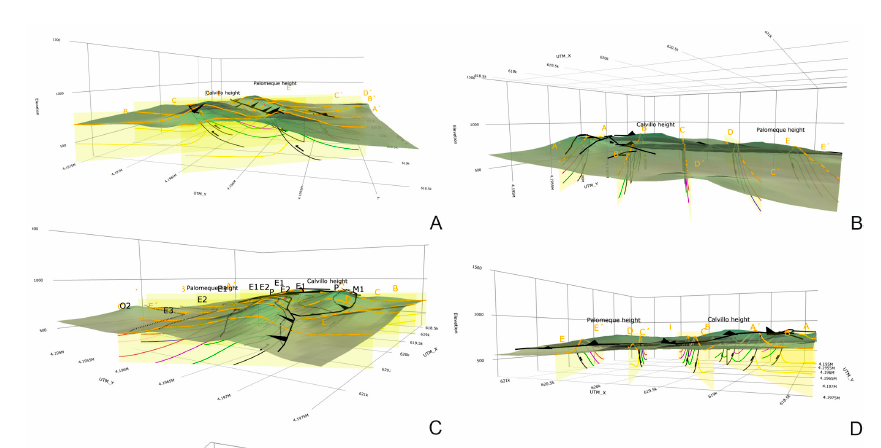
Cite as: Bullejos, M. and Martín-Martín, M. (2023): 3D Visualization of geological structures using Python: the case study of the Palomeque sheets (SE, Spain). Journal of Maps 19, NO. 1, 2282593 https://doi.org/10.1080/17445647.2023.2282593
Field trip in Morocco: Searching for the Nummulites
The Africa call…
Well the third field work campaign the project. This time in the Middle Atlas of Morocco. The objetive was to find Nummulites as the ones in the Betic or in the Rif.
The picture shows the members of the team. Picture taken by Soufian Maaté.
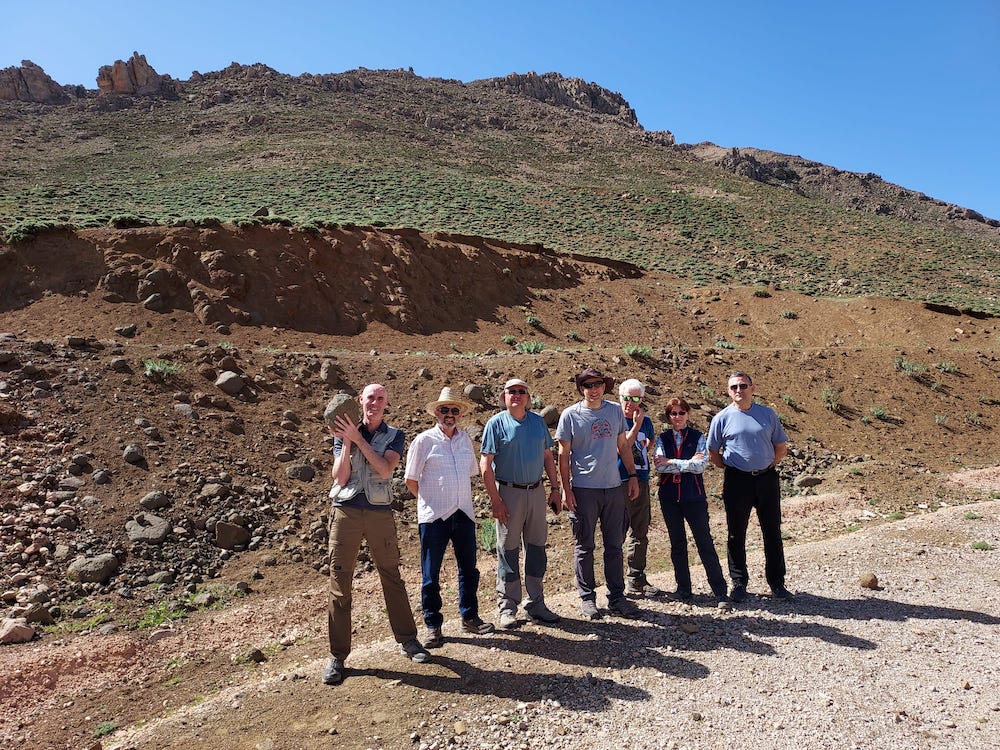
Manuel Bullejos Lorenzo (Granada University)
Rachid Hlila (Abdelmalek Essaádi University)
Ali Maaté (Abdelmalek Essaádi University)
Manuel Martín-Martín (Alicante University)
Soufian Maaté (Moulay Ismail Errachidia University)
Crina Miclăuș (Alexandru Ioan Cuza University)
José Enrique Tent-Manclús (Alicante University)
And the collaborators:
Pedro Robles (Alicante University)
Santiago Moliner (Alicante University).
After a week (from April 23rd until April 30 2023). Many rock samples were taken and we did not find them but our hope is to look carefully the thin sections for tiny Nummulites.
This is the third major field trip of the project of the Spanish research agency (Agencia Estatal de Investigación) of the Spanish Science and innovation minister (Ministerio de Ciencia e Innovación) entitle as “EVOLUCION TECTONO-DEPOSICIONAL DE CUENCAS SEDIMENTARIAS CENOZOICAS: CARACTERIZACION 2D-3D Y MEJORA DE PATRONES ESTANDAR” (PID2020-114381GB-I00). See previous post.
Small scale RT cycles in Prebetic Lower-Middle Eocene (Alicante)
In the study of the Alicante External Prebetic Eocene platforms, ten sedimentary facies were defined in field based on lithology and fossil content observed, as follows: L1 – limestone (lmst.) with Alveolina; L2 – lmst. with small Nummulites (< 3 cm diameter); L3 – lmst. with big Nummulites (>3 cm diameter); L4 – algal lmst.; L5 – lmst. with miliolids; L6 – micritic lmst. with gastropods and bivalves; L7 – marls; L8 – greenish siltstones; L9 – dolomitized lmst. and/or dolostone; L10 – sandy lmst.
The lower interval of the Ibi section twelve L2-L1 units were defined, after which the first dolomitized limestone (L9) occurs, changing the motif to L2-L1-L9 or L1-L9. The middle part of the succession is marked by the occurrence of facies L10, while the upper part by five units with L5-L7.
The lower interval of the Ibi section, consists of thinning-upward units, each one showing a shallowing-upward trend, indicating a decrease of accommodation in middle ramp area, ended with the basinward shift of the proximal open inner ramp. The upper interval, consisting in thickening-upward units, sedimented in lagoon-shoals of inner ramp, indicates increasing of accommodation. This interval is preceded by a period of siliciclastic supply (L10). Consequently, at the scale of the entire outcrop a regressive sequence can be defined with at least 12 smaller RT (Regressive-transgressive) cycles, the lower 6 developed in middle ramp environments, while the upper 6 in inner ramp.
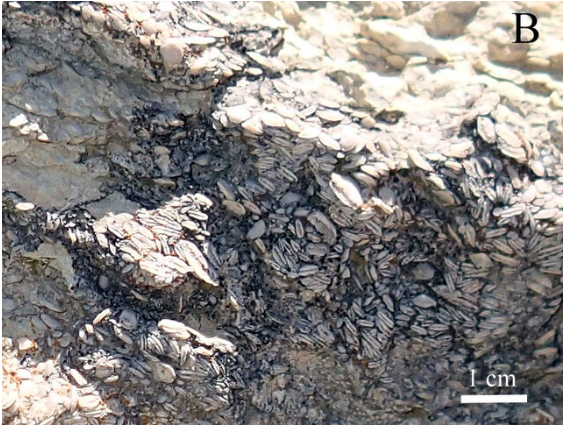
The Prebetic Paleocene-Eocene stratigraphic succession shows a general regressive-transgressive trend. The above-presented results indicate that on the regressive interval of this trend smaller scale RT cycles are superposed.
Cite as: Miclăuș, C., Martín-Martín, M., Tosquella, J., Samsó, J.M. and Tent-Manclús, J.E. (2023): Small scale RT cycles in Lower-Middle Eocene limestones of External Prebetic Units of Betic Cordillera (Alicante Zone). Abstract Book, Fourteenth Romanian Symposium on Palaeontology, Bucharest, 14-15 September 2023 / Zoltán Csiki-Sava, Alina Floroiu, Maria-Raluca Văcărescu, Iuliana Lazăr – Bucureşti : Editura Universităţii din Bucureşti -Bucharest University Press, 2023, 83-84 p.
New biostratigraphic data on the Paleocene-Eocene from the Prebetic
A biostratigraphic study of the Paleocene-Eocene of the stratigraphically continuous with the northern foreland (Iberian Meseta), Prebetic has been studied by using planktonic foraminifera, calcareous nannoplankton, and larger benthic foraminifera. Twelve sections have been studied along the chain: four sections in the Alicante Sector, four in the Murcia Sector, two in the Granada Sector, and two sections in the Jaén Sector.
The Paleocene-Eocene Prebetic succession can be divided into three stratigraphic formations related by lateral and diachronic changes of facies: limestones and calcarenites (rich in larger benthic foraminifera) in middle stratigraphic position, and two marly-clayey formations in lower and upper positions, respectively. The middle unit represents an internal marine platform, while the two marly-clayey represent the external platform (and the upper slope in a few cases). As a whole, above the unconformity, representing the missing interval which includes the Cretaceous-Paleocene boundary.
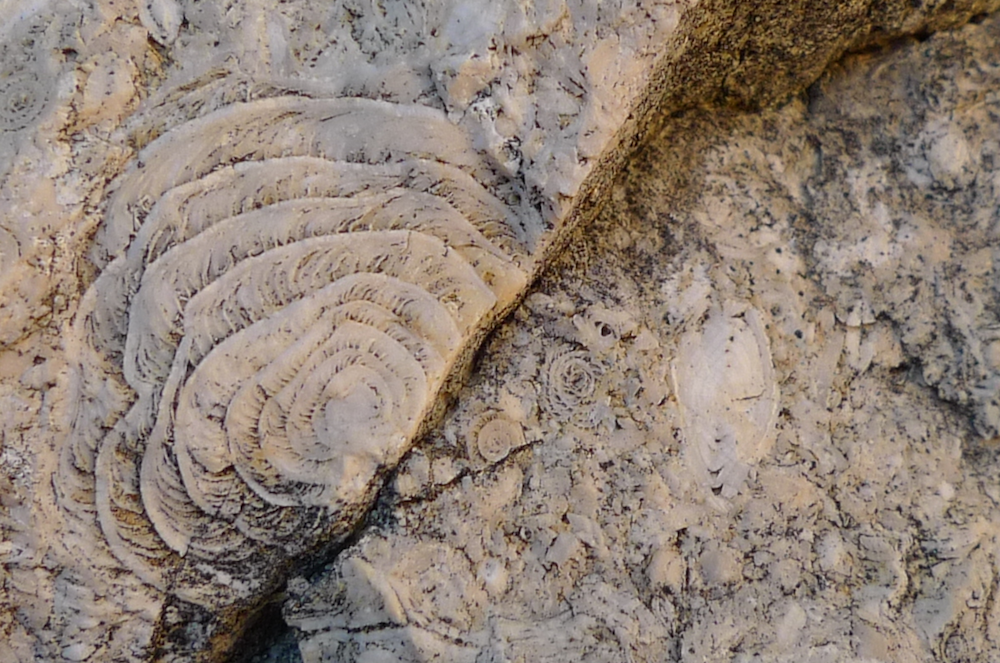
Cite as: Martín-Martín, M., Miclăuș, C., Serrano, F., Tosquella, J., Samsó, J.M., Tent-Manclús, J.E., and Martín-Pérez, J.A. (2023): New biostratigraphic data on the Paleocene-Eocene succession from the Prebetic domain (Betic Cordillera: South Spain).Abstract Book, Fourteenth Romanian Symposium on Palaeontology, Bucharest, 14-15 September 2023 / Zoltán Csiki-Sava, Alina Floroiu, Maria-Raluca Văcărescu, Iuliana Lazăr – Bucureşti : Editura Universităţii din Bucureşti -Bucharest University Press, 2023, 79-80 p.
History of western Tethys Ocean and the birth of the circum-mediterranean orogeny as reflected by source-to-sink relations
A broad region of Mesozoic to Cenozoic tectonism along the western and central Circum- Mediterranean (CM) margins, from southern Spain (Betic Cordillera) to the northern Morocco (Rif) and Italy (Apennines), includes huge volumes of sedimentary record since the Late Paleozoic. These sediments are contemporaneous and related with the fragmentation of the Pangean supercontinent due to the rifting and progressive closure, as well as the following birth of the CM orogeny. The composition and stratigraphic relations of clastics in diverse sedimentary basins of the CM region reflect a complete record of provenance relations related to the progressive destruction of the Neotethyan Ocean and plate convergence between the two major plates of Europe and Africa, and Iberia, Adria and Mesomediterranean microplates located between them. The changing nature of clastic wedges reflects the provenance relations from different source rocks involving obduction of the oceanic lithosphere, the uplifted Alpine-Mediterranean Chains, and the accreted previously deformed Mesomediterranean Microplate (AlKaPeCa), as well local neovolcanic sources, within the spatial and temporal evolving geo-puzzle terranes of the CM orogeny. The provenance evolution of sediment provides insights into how plate convergence and continental collision direct the sediment dispersal pathway in Cenozoic basins due to closure of eastern and southern Alpine-Tethyan remnant ocean basins and to the dual dispersal pathways from the previously born Alps and the nascent AlKaPeCa at the expenses of the previously deformed Mesomediterranean terranes. The source-to-sink relations testify episodic deformation events, diachronous Tethyan basin development, differentiate sediment provenance from exhumed and uplifted Alpine and CM orogens, and palaeogeographic rearrangement of crustal blocks along the nascent Mediterranean region.

cite as: Critelli, S.; Martín-Martín, M. 2023. History of Western Tethys Ocean and the Birth of the Circum-Mediterranean Orogeny as Reflected by Source-to-Sink Relations. Int. Geol. Rev. 1–11, doi:10.1080/00206814.2023.2280787.
Recent Comments